Bloodthirsty gods and gracious men: the brutal truth about Vikings
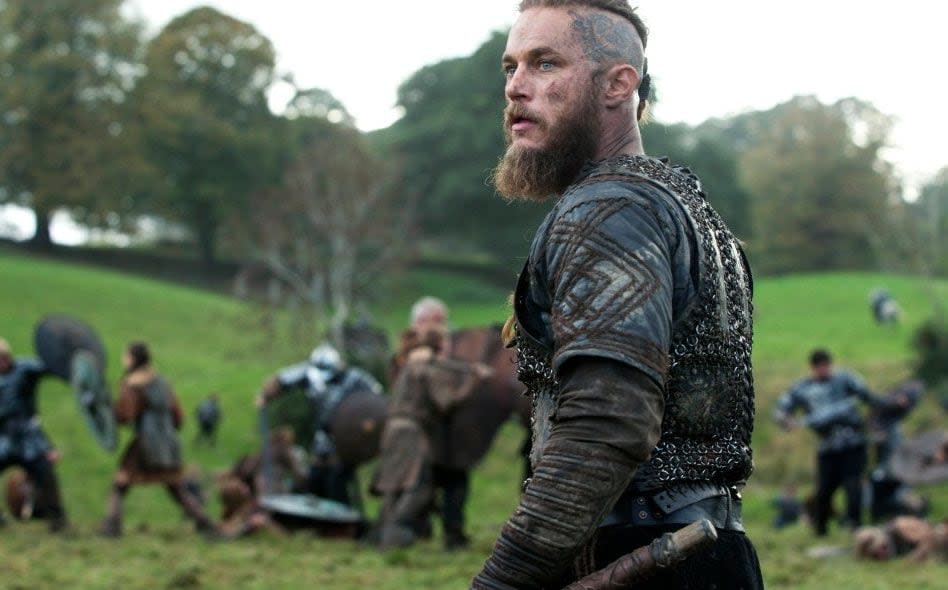
Somewhere in the Wicklow Mountains, actor Travis Fimmel was hung in a cage – suspended high above a pit of venomous snakes. These were the final moments of Fimmel’s hero, Ragnar Lothbrok, in the historical drama Vikings, based on the legendary Norse warrior and king Ragnar Lodbrok – as immortalised by Icelandic sagas of the 13th Century – and real Viking history.
By the time he was hoisted up in the cage, Fimmel had played Ragnar for four seasons. He was about to meet his maker as detailed in the Icelandic sagas: dropped into the snake pit by King Aelle of Northumbria (Ivan Kaye).
The scenes were filmed in the thick of the Irish winter. Michael Hirst – the creator and writer of Vikings – remembers it being brutal. “They’d been in this pit on the Wicklow Mountains for three days, covered in mud,” says Hirst. “It had been pouring with rain the whole time.” With conditions that would fray even the most placid tempers, there was a disagreement over Fimmel’s final speech. The speech was based on the Lay of Kraka, a skaldic poem that purports to be Ragnar’s final monologue, as he lay dying in the snake pit, reminiscing about his many heroic (albeit quite violent) deeds.
“Mate, I’m not going to say those last words,” said the Australian actor. “I don’t give speeches… I haven’t learnt it.” Hirst pleaded with both Fimmel and the director, who proposed a solution: they would relay the speech to Fimmel via an earpiece. “Do what you want with it,” said the director to Fimmel. “It’ll be in your ear.”
“So, Travis is hauled up in the cage,” recalls Hirst. “It was pouring with rain. It’s horrible. All these extras are below getting soaked. Travis starts beating the side of the cage, swaying the cage side to side, and shrieking at the top of his voice, ‘I hate Michael Hirst! I hate Michael Hirst!’”
But in the heat (or unbearable cold) of the moment, Fimmel spat out Ragnar’s final words – a searing, adrenaline-spiking swansong. “It sounded completely authentic,” says Hirst. “After an hour someone said, ‘Can we bring him down and give him a cup of coffee? He’s freezing.’ I said, ‘No! We’ll never get this moment again. Leave him up there! He’ll be grateful in years to come.’”
When Fimmel was eventually released from the cage – down into the pit – he was bitten for real by (devenomized) snakes. “He insisted on doing it,” laughs Hirst. “That’s Travis – he’s Australian! He’s not frightened of a few snakes… By the way, I still love him. We’re still friends…”
The sequence perfectly encapsulates Vikings – a show with absolute fealty to its sources; that put huge physical demands on its actors (fighting with real weapons and at one point heaving an actual Viking boat up a cliff, after Hirst learned that Vikings did that very thing to avoid blockades); and a show which had a deep passion for its characters. That’s not to mention, of course, having the guts to kill off its lead character several seasons in – long before the story was finished – a move which the American producers had warned Hirst against.
Vikings had more muscle and guile than initial impressions. Coming two years after Game of Thrones, it was much more than just Westeros-lite. It may have looked like Vikings came in the wake of Game of Thrones, but Games of Thrones really came in the wake of Hirst’s other hit series, The Tudors. Hirst – who also wrote the Cate Blanchett-starring Elizabeth – was the originator of the edgy, highly-sexed, cut-throat historical romp.
“I never watched Game of Thrones,” says Hirst. “I didn’t ever want to be accused of borrowing from it, or being influenced by it at all. What I say, which doesn’t always go down too well, is that Vikings is a more significant show because Game of Thrones is a fantasy. In a fantasy anything can happen. So essentially, if you think about it, it’s meaningless. It can be entertaining. I’m sure it was fantastically entertaining. But it’s meaningless and it has no relevance to the real world.”
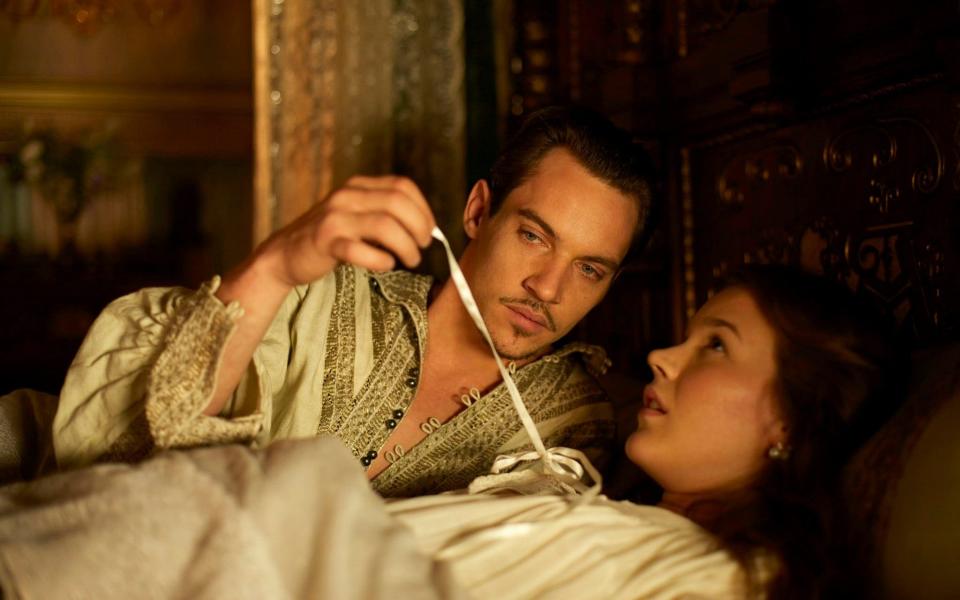
Now Vikings has returned for a sequel series on Netflix, Vikings: Valhalla, from showrunner (and writer of Die Hard) Jeb Stuart. “People think coming in and following Michael Hirst is a slam dunk,” says Stuart. “It’s anything but… Michael did a brilliant job of taking a group of people we thought we knew – medieval people – and making them real. They cried when their children died, they fell in love.”
Hirst began researching Viking history for a potential (but ultimately unmade) film about Alfred the Great. He was surprised by how little he knew. The Vikings didn’t write down their history; much of what we know about them, and the popular berserker-like image, comes from the histories of monks and traders.
“The word ‘Viking’ prompts an immediate visceral response,” says Hirst. “They are traditionally ‘the other’ – fearsome beasts who break down your door in the middle of night, rape your daughters, steal your goods, and burn your house down. That ferocity and bad behaviour came largely from Christian monks, who wrote the narrative. But I really got into Vikings – their social structures, their paganism, their weird and wonderful sagas.”
Hirst returned to the idea years later when MGM was looking to resurrect The Vikings, the 1958 smackdown between a one-eyed Kirk Douglas and skirt-wearing Tony Curtis. “One of the worst films in the world!” says Hirst.
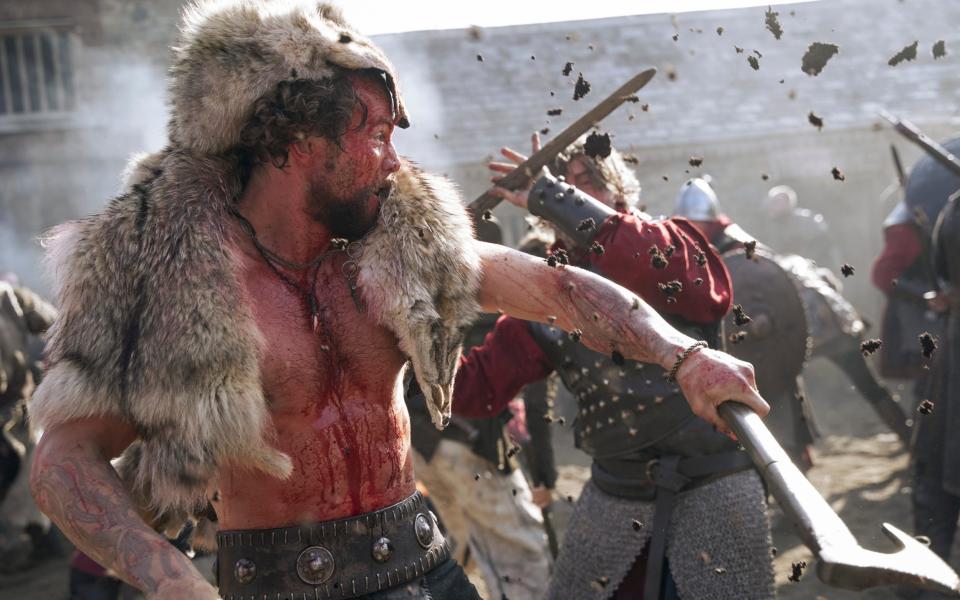
When pitching the show to the History Channel in New York, executives asked why Americans would be interested in Vikings. “If you leave this office and walk two blocks, you will have passed at least 40 or 50 people with Viking DNA,” Hirst told them. “We’re all sort of descended. Vikings were everywhere.”
Vikings debuted on the History Channel in Canada on March 3, 2013. It ran for six seasons – unusually for a series of this scale, Hirst wrote all 89 episodes himself.
The series begins with Ragnar, a farmer and keen explorer, defying the Earl of Kattegat (a brilliantly-mulleted Gabriel Byrne) to sail west and raid the holy island of Lindisfarne, off the Northumbrian coast. The real raid – which happened in 793 – is commonly considered to have started the Viking Age.
From there, Vikings tells the saga-like story of Ragnar, future King of Kattegat and Denmark; his brother-turned-rival Rollo (Clive Standen); Ragnar’s wife – and tough-as-nails shieldmaiden – Lagertha (Katehryn Winnick); boat builder Floki (Gustaf Skarsgård); and – as the seasons progress – Ragnar’s sons. The lead characters are based on real legends and historical figures. “Ragnar was the first Viking leader to emerge from the myths and legends,” says Hirst. “There’s some dispute about whether he was real. I think he was real and so does my historical advisor.”
Vikings takes some dramatic liberties. According to the history and legends, Ragnar and Rollo – the first ruler of Normandy – were not brothers and lived around a century apart. But Hirst based Vikings on real and plausible history, written with guidance from British historian Justin Pollard.
“The Vikings didn’t write anything down,” says Hirst. “I didn’t want historical accuracy because there’s no such thing. But I wanted the drama to be as authentic, plausible, and as real as it could be. Most of this stuff you couldn’t make up anyway – the burial rituals and so on. And I would find out things. Who knew that a Viking army attacked the walls of Paris? That was just extraordinary. I knew I had to have that. [The Siege of Paris of 845 takes place in Season Three.] I always asked the researcher, Justin Pollard, whether he felt if things were plausible, authentic, or possibly true.”
Pollard has continued as an advisor for Jeb Stuart on Vikings: Valhalla. Stuart says the key question when writing the series was not “did this happen?” but “could this have happened?” “He must think, who’s this American running around in the playground of history?” laughs Stuart.
From the get-go, Michael Hirst pitched Vikings as the story of Ragnar and his sons – Bjorn, Sigurd Snake-in-the-Eye, Ubbe, Hvitserk, and Ivar the Boneless (“Who doesn’t want to meet a character called Ivar the Boneless?” says Hirst).
The plan was to kill off Ragnar in Season One. “But when he was made flesh, when Travis came along, there was no way I could get rid of him,” says Hirst. “He’s one of those actors. He doesn’t need to say anything. He just needs to look.”
Vikings is a show about many battles, figurative and literal: the battle between Vikings and Anglo-Saxons (which delves into English history via the Viking raids); the battle between Vikings and Vikings (indeed, nobody can sail anywhere without some usurper snatching their kingdom); and the battle between Christians and Pagans – a tension explored and tempered by the relationship between Ragnar and the Anglo-Saxon monk Athelstan (George Blagden), first enslaved and then befriended by Ragnar.
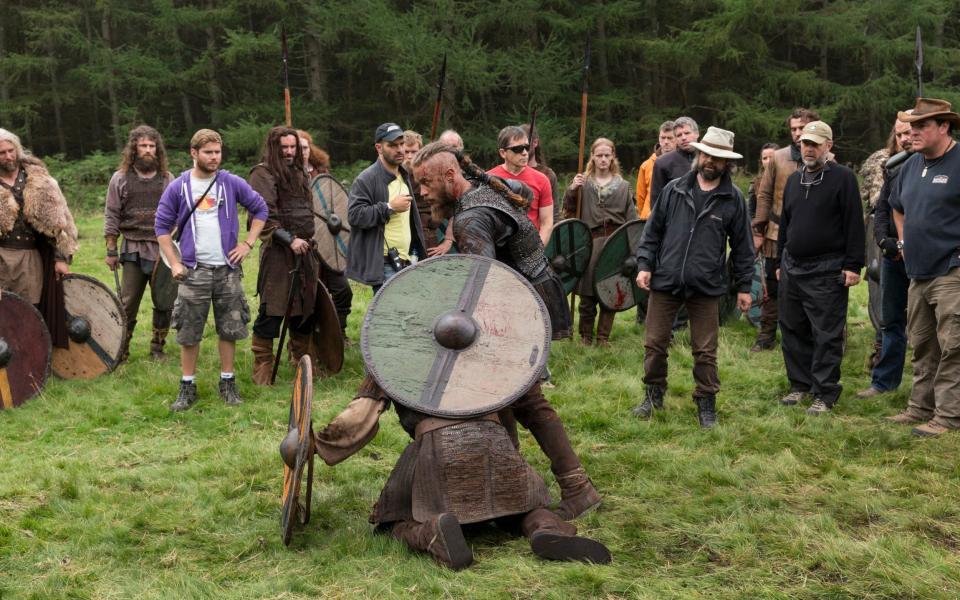
Vikings is rarely about the battle between good and evil, however. The morality is far murkier than that. “The Christian cultures, like the Saxons and the Franks, were often so hypocritical,” says Hirst, bringing to mind a scene in which sweet Saxon princess Judith (Jenny Jacques) has her ear shorn off by Christians for adultery. “Yet, the Vikings, who believed in such weird and bloodthirsty gods, could be so gracious. I love those contradictions.”
Indeed, Ragnar is epic-level complex: a noble warrior, king, murderer, father, and philanderer all at once – Tony Soprano with an axe and longboat, guided by visions of Odin. His first adventure, after all, is the massacre of peaceful, terrified monks – and all for the sake of pillaging a few tacky goblets and candlesticks.
Later, Ragnar becomes hooked on a “medicine” given to him by a Chinese slave-cum-lover; when she refuses to fuel the habit any longer, he drowns her. “He murdered his drug dealer!” says Hirst. “That was Travis’s idea. Travis and I would talk endlessly about this character – where he’s going, what he would do, what his limits are. Travis would push me on, wanting to be shocking. Shockingly violent sometimes. I pushed to be morally ambivalent in a real way.”
If there’s one comparison that can be drawn to Game of Thrones, it’s Vikings’ tendency to up the ante with grisly deaths. No characters – especially your favourites – are safe. Part of the fun is waiting to see who will perish, and how. Just when you think some chap getting a crossbow bolt through the larynx is bad enough, he then gets castrated for good measure.
Hirst insists that he wasn’t thinking up harrowing deaths for the sake of it. “Too much TV is done just for effect,” he says. It’s easy to imagine that the actors now wear those deaths like a badge of honour – YouTube-able moments of can’t-look-away brutality. One of the producers had the grim job of informing the cast members about their impending, sometimes unexpected deaths. “We called him ‘the angel of death,’” laughs Hirst.
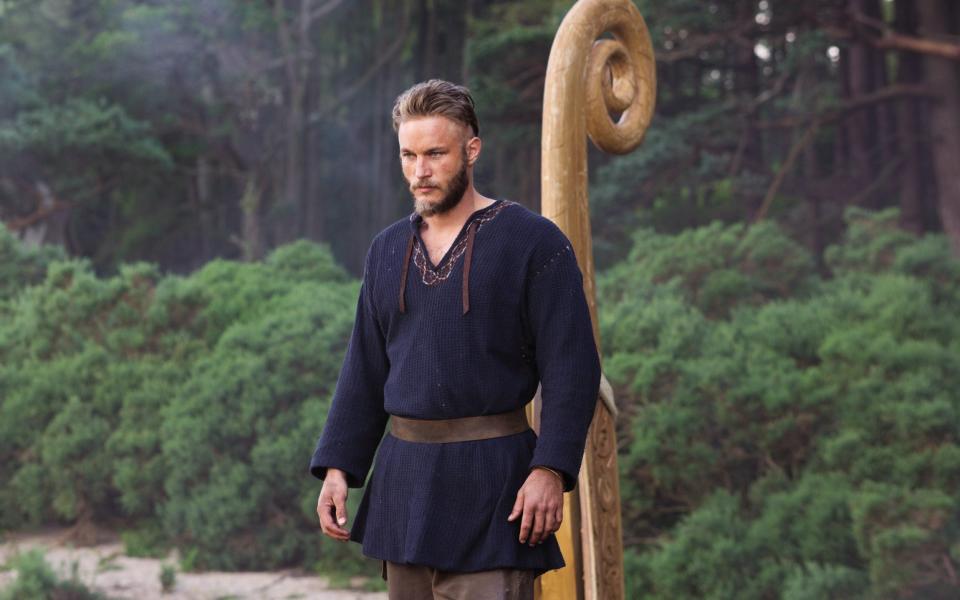
Most notorious is the “Blood Eagle” execution, a legendary torture (though historians debate whether Vikings actually did it) in which the ribs are cut away from the spine and opened outwards like wings, and the lungs pulled out through the back. Ragnar performs the Blood Eagle twice – first on enemy-turned-ally-turned-enemy-again Jarl Borg (Thorbjørn Harr), one of the series’ most powerful, soul-curdling scenes. In the story, Borg must hold his silence during the ordeal to enter Valhalla.
“The Blood Eagle is unspeakable of course,” says Hirst. “The Americans – MGM – said they wouldn’t allow us to do it. I said that we could shoot it in a certain way. It isn’t voyeuristic – it’s giving this guy the chance to show how brave he is. I talked to the director at the time [Kari Skogland]. She loved it too. She said, ‘Let’s do it, we won’t tell anyone, they can cut it if they want.’ I remember going down to the studio. It was at night and there were hundreds of burning torches. I’ve never felt more electricity in the air. It wasn’t horrible – it wasn’t shot like that. It had a morality to it. Of course, they didn’t cut it – it was so well done.”
By season four, producers had also lost their nerve about killing off Ragnar, assuming that audiences were tuning in just for Travis Fimmel. It was now the second biggest show in the world – only The Walking Dead was watched in more countries.
But the audience held strong after Ragnar’s tumble into the snake pit. “I think Travis had been persuaded by some of his people that he was the be all and end all of Vikings,” says Hirst. “He made the mistake of calling MGM about the viewing figures – not about the show where he died, but the episode after – expecting them to have fallen off a cliff. MGM said, ‘Sorry to tell you this but the viewing figures have gone through the roof.’”
While Ragnar’s sons picked up the main thrust of the story, its most powerful player was Lagertha – she outlived Ragnar and matched his strength as a lead character. Hirst recalls taking “violent exception” to some historian claims that Lagertha couldn’t have been a warrior in her own right. Katheryn Winnick, who played the role, is a black belt. “Her first job on set was to teach other women to fight,” says Hirst. “That’s one of the reasons I cast her.”
Hirst took more creative licence for the show’s conclusion, by having his Vikings reach America. “Remains of a Viking settlement were discovered in Newfoundland,” says Hirst. “But that dates back to a later period. Towards the end of the Viking age.” The last episode aired in December 2020.
Vikings: Valhalla picks up the story more than a century later. “Michael reached a fabulous conclusion in his show,” says Jeb Stuart. “The last thing I wanted to do was make Season Seven. I felt we had to move the story down about 125 years. That allowed us to have a sphere of powerful characters, to tell the story of the last part of the Viking era.”
With a new cast of historical figures – Leif Erikson (Sam Corlett), Freydís Eiríksdóttir (Frida Gustavsson), Harald Hardrada (Leo Suter), and King Canute (Bradley Freegard) – Vikings: Valhalla also begins with a slaughter: the St. Brice’s Day Massacre of 1002, in which King Aethelred of Wessex ordered the killing of Danes in England – retaliation for Danish raids.
There’s a new dynamic to the show, too, as the Vikings are now split by religion – half Pagan, half Christian – a theme which echoes 21st Century. “I think the audience may find some discomfort in that,” says Stuart. His historical figures are better documented, too, but Stuart plays within the grey areas of history – much of them packed with gripping Viking punch-ups. It's a pacier show. “Let’s be honest,” says Stuart. “Michael wrote Elizabeth, I wrote Die Hard – there’s a lot of action.”
It keeps the Viking spirit, however – the thing that always made it an intriguing show. “What really fuelled the show was my own fascination with Viking culture and paganism,” says Michael Hirst. “I wanted to open other people’s eyes to the richness and extraordinary nature of this culture.”
Vikings: Valhalla is on Netflix now

